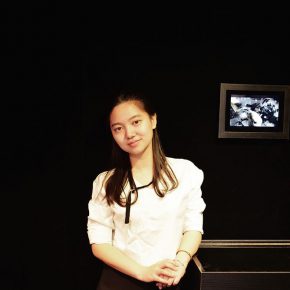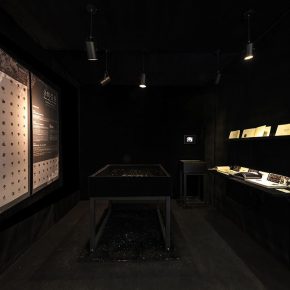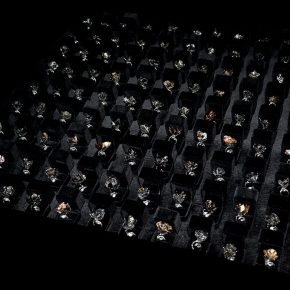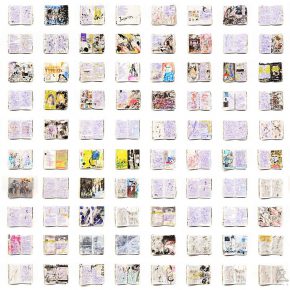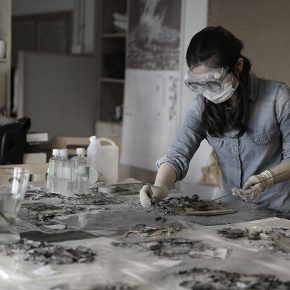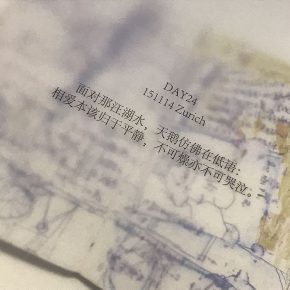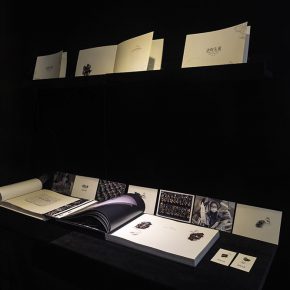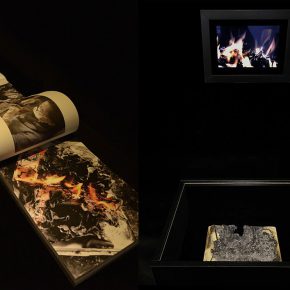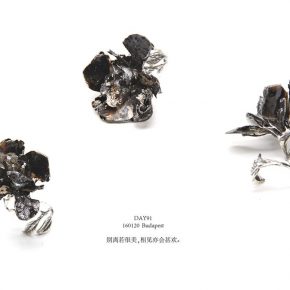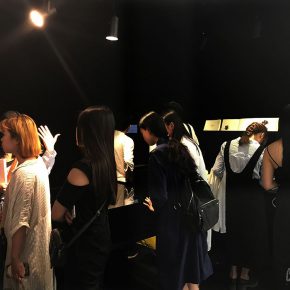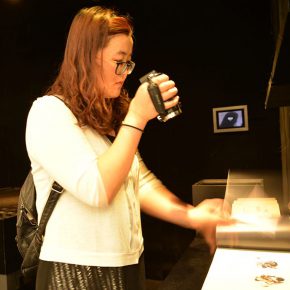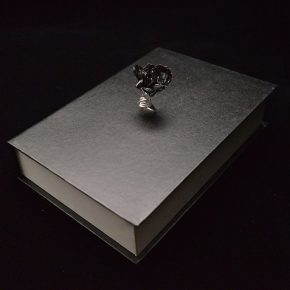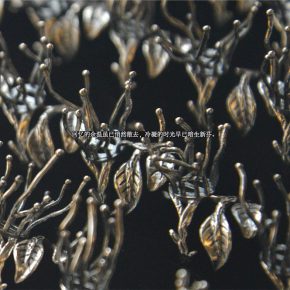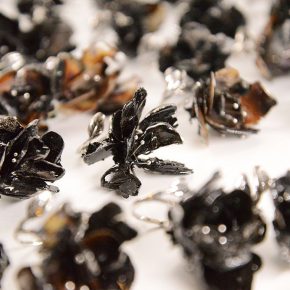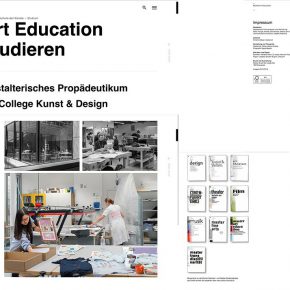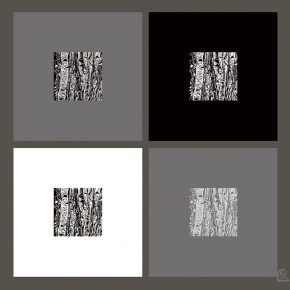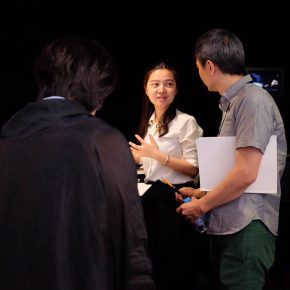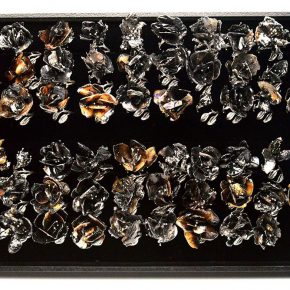
Since 2014, CAFA’s School of Design has gradually promoted and introduced an innovative educational reform in design, which is full of broad and rich content. This educational reform, with an interdisciplinary and diverse approach, attempts to cultivate design creators with rich souls, practical creativity, and the ability in independent thinking.
The 2017 Graduation Exhibition for master students at CAFA’s School of Design opened at the popular campus exhibition hall. At the center of the exhibition hall, there was a tranquil, unconventional, dark space covered with black velvet. Inside this space sits 99 petal-shaped pieces of conceptual jewelry made of ashes. These jewels were the creation of CAFA’s master graduate Zhang Yizhi showing her comprehensive conceptual design, “The Flowers of Embers”. With its strong visual appeal, and distinctive way of materializing emotions, Yizhi’s work has resonated with many visitors. Its design language has emotionally bridged the creator and the spectator, allowing the power of design to leave a vibrant and everlasting aftertaste in people. Today, we will have a close look of Yizhi’s work in order to reveal the process of “flower-making”, to learn the story of “embers”, and to understand the designer Yizhi’s conceptual inspiration, design practice and interdisciplinary exploration.
Zhang Yizhi obtained her bachelor’s degree at the Space Exhibition & Design Studio under CAFA’s School of Urban Design in 2014. In the same year, Yizhi entered the Design Education & Research Studio with a top overall ranking at the School of Design. She studied under the senior professor Zhou Zhiyu, and was edified with some comprehensive knowledge such as design education, Semiotics, and Iconography. Yizhi has also become one of Professor Zhou’s last class of graduates. In 2015, during Yizhi’s second year in graduate school, she was fortunate to enjoy an exchange with the Institute for Cultural Studies in the Arts at Zurich University of the Arts in Switzerland. While studying abroad, she also visited many museums, art galleries, design institutes, and participated in foreign exhibition compilations. Yizhi has devoted herself to an exploration of comprehensive design theory and design practice.
The Visual Trace Engraved in Time
Once you step into the exhibition area of “The Flowers of Embers”, you will be first attracted by the flower-shaped jewelry sets that glow subtly and delicately. The powerful sense of form of the work seems to convey monumentality. As you observe it carefully, you will find that each petal in dark grey is unique and irregular, some of the “petals” even have some illegible handwriting left on them. As you begin walking around the exhibition space, posters, videos, and books unfold in front you gently. You, as the spectator, were being brought into the scene with some “planned” mysterious clues – the jewelry sets are actually made of ashes, which become the key to link the storyline.
Time flies, memories could only be treated as an abstract blurry mark. However, as the architect Peter Zumthor once said, “the images in our memories are not like the frozen fragments stored in our brains”. The entire process of recalling is dynamic. People complete the meaning of life by repeating the cycle of connecting the “fragments of memories” and longing for a “future dream”. Yizhi likes to think and record – the readable text and the hidden icons together make the record. Any genuine experience and individual emotions that are hard to tell verbally will be embedded in this record, in the form of continuous whispering, or somber chatting to oneself. This design would be rooted in a diary that congeals a special friendship between women. 99 days of image-text journals are taken as the carrier of memories. There’s no need to define the friendly sentiments, as the experience has become the key to open the door to growth.
The Dark Grey Aroma of the Reborn Ashes
Diaries are the ruins of time and ashes are the presentation of ruins. They themselves imply a gaze that looks backwards, as well as the object of the gaze, which has already become a disappearing entirety.
“I attempt to convey the metaphorical emotions by designing with the external form”, Yizhi said.
The privacy of a diary is the rule of its existence. The secrets cannot be open to the public, but the emotion could not be concealed. Therefore, burning-down becomes the method for keeping the secrets and burying memories, it also provides the possibility for displaying the externalization of conceptual design. Ashes become another form of expression for the emotions embedded in the diary, meanwhile, it has become a commemoration for renewal and rebirth. In order to enable the photography of burning, Yizhi has previously experimented many times.
“I cried a lot when it came to the burning of my original diaries. My eyes were swollen for two days, which I thought may be due to the intense flame. Sometimes I was just staring at the fire, perhaps I was having a hard time letting go.”
The artistic concept was able to be converted through a design approach. The shape of the jewelry was taken directly from the meaning of another girl’s name in the diary, Jasmin (in Chinese pronunciation is: Moli). The subtitle YIZHI ·MOLI not only tells the implied relationship between the two girls by literally spelling out their names, but also leads to another intriguing verbal interpretation, “a jasmine flower”. 99 pages of diary have been converted to 99 petal-shaped delicate jewelry accessories. With the balmy breath of jasmine flowers, the jewelry sets stand for the feminine emotion. The whispering, fascination, obsession and entanglement in embers have all been condensed in the dark, fragile and unique materiality.
“Though my work originated in emotion, the process of making was quite rigorous. Ashes resulted from burning pages of the diaries which were drawn carefully and time marked, the barely visible handwriting corresponds completely with the diary. On the flower jewelry with December 23rd time marked, the date record is easy to read due to incomplete combustion. Only when the sentiments and thinking of design have merged with rigorous and rational logic, could the integrity and fineness of the work be reflected”, Yizhi said.
From the 1mm silver claw-like structural design to the mix and making of every ember flower petal, including the record and filming of burning were all completed by Yizhi alone.
“The most important issue was to solve the problem of structure and material. At an earlier stage, I tried acrylic, plaster, silicone moulding, in the end I chose the combination of silver, resin and ashes. The contrast between the shininess of metal and the darkness of ashes implies contradiction.”
Through a diary, an experience was presented and through concept design, the concept of artistic behavior was able to be externalized. Emotions opened up the foundation for design planning, including the time span.
The comprehensive conceptual design can be divided into 4 parts, finished jewelry products, video records, original diary scripts, conceptual books. All four parts respond to each other.
“The spectators will first see the finished jewelry product, then they will gradually begin to understand the overall design process. In fact, this is a detective drama that requires patience and meditation.”
In the video, the bonding pieces of paper were being devoured by the violent flame, and the sorrowful and deep sentiment linger in the melody played by Jasmin. Covered by the delicate tracing paper, the original diary became partially visible. Sentiments were congealed through the words extracted by the thin paper.
Jewelry is the carrier of sentiments, it’s also the design product resulting from externalizing concepts. From the diary, to the chemical transformation of burn-down, then to the product of a new design, the flowers have arisen from the ashes, obtaining a purer abstract life. The cycle of life goes on and on in birth and rebirth. Like what Márquez once said, “Things have a life of their own. It’s simply a matter of waking up their souls.” The artistic concept gains rebirth through the externalizing design. Sentiments wake up the souls and allow them to grow wildly.
The Sentimental Echo is Condensed into Memories
From the spray paint on the cloth cover of the books to the handcrafted lock stitch, from the cushion on the showcase to the exhibition mode in the black velvet space, everything was designed and extended around the main objects displayed. All the handling of details was meant to serve the expression of concept, and to create the best presentation in the limited space. But what Yizhi did not anticipate was, “The Flowers of Embers” which gave rise to some feedback that was beyond her expectation. It was the spectators’ intention to have one guest book to leave comments. The dense handwriting on the guest book showed everyone’s embers in memories, and their sentimental whispering. People made an online chat group just for this exhibition to exchange their feelings. Once there were two girls that told Yizhi that they were crying while flipping through the diaries and they stayed in the black compartment for one to two hours. There were also spectators saying that, “The aftereffect was so strong that it made me feel depressed for days…”
The rich feedback from the spectators has become the unplanned “extra quintessence” of the finished product.
“Actually, the artworks are personal. I did not assume the mind of the spectators. It was all about creating the experience. It’s very likely that the spectators are only able to perceive 10% of the work and the hardest 90% will only be understood by myself”, Yizhi said.
“There was one comment that really impressed me. It said that, I thought I was experiencing what you have experienced. In fact, I am recalling what I remembered”.
The sentimental power of design is very clear in Yizhi’s “The Flowers of Embers”. Although it used the creator’s personal experience as a starting point, it was based on vivid sentimental accretion, that connects people with the most delicate and fragile shared emotional experience. It can strike people’s hearts deeply.
Just like what Stendhal wrote in his letters to Pauline in 1805: “During our trip, we will meet all sorts of people. Some are similar to ourselves with passionate souls…we were born to be the friends of these great souls. We will take their happiness. We will be in love with each other forever as long as our feelings are connected.” People encounter each other in an undetermined space-time. Some people may not be able to always be with you, but they will become the glimmer that remains shinny in an individual’s life. In the ashes of your memories, they will become the nutrient for your growth. Whether you are happy or sad, eventually you will begin to grow and change. In the cycle of time, you will blossom in your own form.
The flowers that arise from embers, are not only the conceptual recollection of the past stories, but also the metaphor and sublimation of the process of how life grows. The comprehensive conceptual design becomes the presentation form of artistic expression. That is, although the memories are no longer fresh or warm, the condensed time has long been fragrant and silent.
The Comprehensive Exploration of Interdisciplinary Design
Actually, at the beginning Yizhi did not limit the graduation project to some specific form. Instead, she was just trying to focus on the core concept of the design under her supervisor’s guidance. Once she linked all the keywords, the design product was “born” naturally. In some degree, this shows the wide scope of the comprehensive design, the interdisciplinary teaching mode of the School of Design, and the free atmosphere for creation at the Design Education & Research Studio.
Yizhi has strong practical and operational ability, and she was good at expressing her ideas. She demonstrated her pure artistic inspiration as early as the first year of graduate school, in her design of the wooden print’s graphic language. During Yizhi’s exchange in Switzerland, she also tried to combine silk-screen printing with design language, and won praise from the foreign teachers. Later on, the photos of Yizhi working on the silk-screen printing were displayed on the official website and brochure cover of Zurich University of the Arts.
“Although it was really hard for me to communicate in German at that time, design and art have helped me to express myself. The artistic sharing filled the gap of cross-linguistic communication.” Art and design have this magic power that makes your work speak for itself.
Yizhi has always kept her habit of reading and thinking. She has never separated other artistic forms such as poetry and drama from design. Instead, she looks for unique inspiration and soulful connections from the rich spiritual world of Marina Tsvetaeva, Samuel Beckett, Richard Wagner, and Antonio Vivaldi.
“It becomes the closest moment when I get to them when I’m reading and appreciating their work. By doing so, it frees me from the limit set by my discipline, so that the meaning of design can be widened.”
From the studies of architecture, space and exhibition design in undergraduate years, to the learning of iconography and semiotics, Yizhi’s knowledge frame has been gradually extended and further developed. Professor Zhou has always reminded them that, “Artists create languages, and designers choose the languages”. Only when you’ve learned various languages of creation, could you understand design in a deeper way, so that you would be able to select the optimal cover for all routes.
“Only when I keep exploring, can I find design methods that suit me.”
Flowers Blossom endlessly, New Journey awaits After Graduation.
The Japanese industrial designer Masayuki Kurokawa once said that, “On the one side is the DNA of the past flowing into your body, on the other side is the hope for future dreams growing in your mind, design leaves its trace in the echo of the past and future”. “The Flowers of Embers” gives out a delicate fragrance of design, and wakes up the sentimental echo. Meanwhile, it shows the designer’s ability to think comprehensively. Contemporary design has advanced with time and broken the interdisciplinary boundary. In a diverse and comprehensive context, contemporary design influences, transforms, and reconstructs the way people think and live. Yizhi’s thesis defense has won much applause among students and professors. CAFA hopes to edify more and more graduates that are intelligent, detail-orientated and with a good working attitude.
“I have always been grateful for the freedom that CAFA has given me over my seven years of studies. I appreciate the inspiration I’ve gained from my teachers, the support gained from my friends during my toughest time. My experience at CAFA is precious”, Yizhi said.
“’The Flowers of Embers’ concludes one stage of my life. It condenses my understanding of the world over recent years. It could also be a brand-new start, as its rich possibilities will encourage me to explore further.”
After hearing Yizhi has her own column on CAFA’s Graduation Season report, Professor Zhou, and Yizhi’s PHD friend Lu Ying have sent their best wishes:
During her graduate studies, Yizhi has always been hardworking and good at thinking. What really impressed me was that, she could rapidly transform her design thinking into the practice of creation. At the studio, she read a lot during her studies of semiotics, iconography and print language conversion which helped her to enrich her interdisciplinary knowledge frame. Yizhi focused on the construction of the overall academic thinking, while she was also highly artistically sensitive. Her ability to analyze and think rationally is what enables her to mix knowledge with practice.
–Zhou Zhiyu, the supervisor at the Design Education & Research Studio
Time is like a tree with all kinds of possibilities. Now, the tree has blossomed. Yizhi freezes the time and memory in a spiritual way. After the ashes coos down silently, with an enthusiastic ceremony, Yizhi makes the flowers of time rebloom like a miracle. The ceremony itself is an interpretation of art, and a translation of design. Deep down the dark glimmer of the ember flowers mean we hear the tide of time, and touch the burning flame of memory.
–Lu Ying, the PHD student at the Design Education & Research Studio
Text by Bansi and edited by Lin Jiabin/CAFA ART INFO
Translated by Miao Yinan and edited by Sue/CAFA ART INFO
Photo Courtesy of Zhang Yizhi


